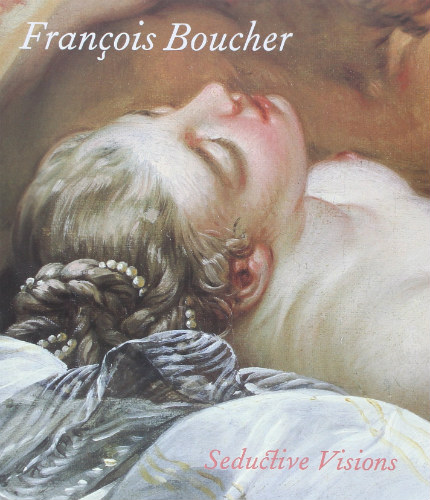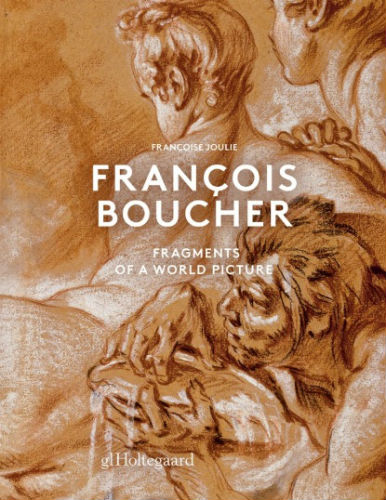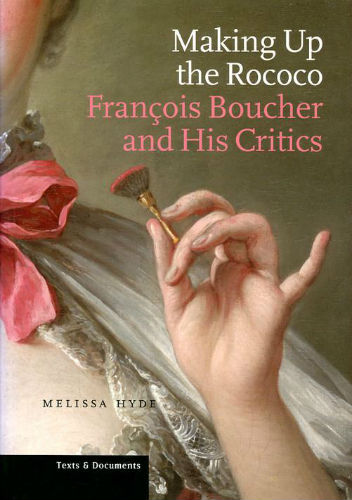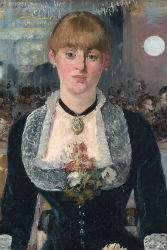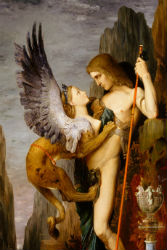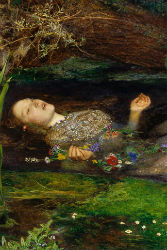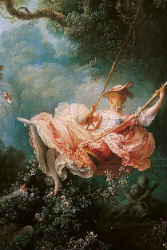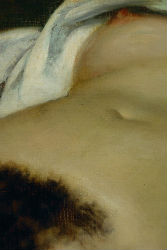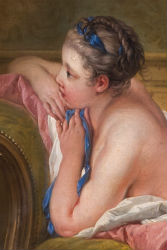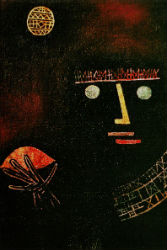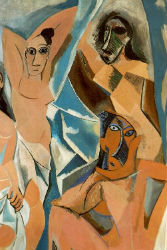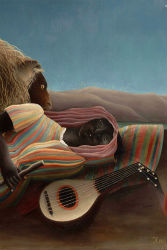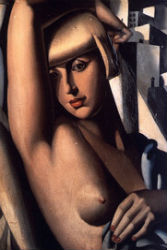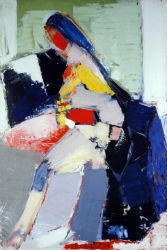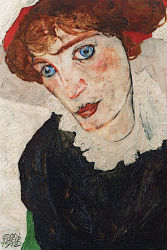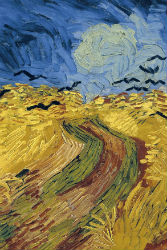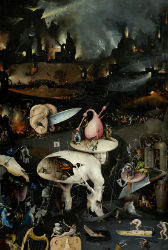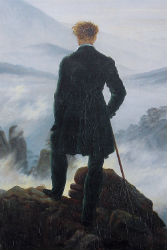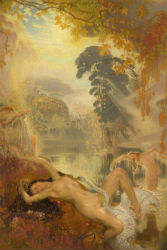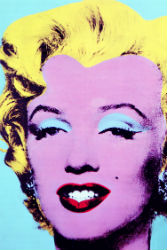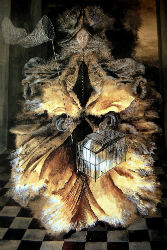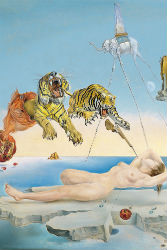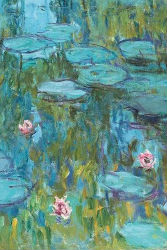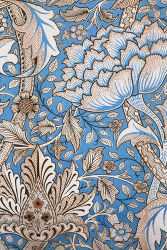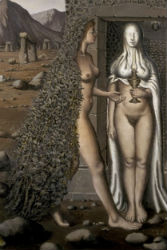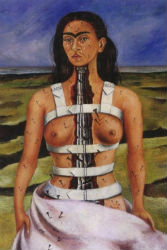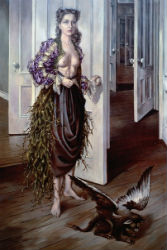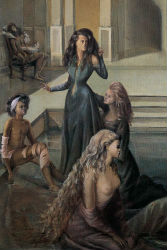François Boucher
Mademoiselle O’Murphy
FROM ‘MARA, MARIETTA’
Part Three Chapter 8
When you surprised yourself in the mirror, when you became a stranger to yourself, who was the who you dreamt yourself to be?
̶ Mirror, mirror, tell no lies, how do I look in Boucher’s eyes?
̶ In brush strokes that caress the canvas, in paint sensually applied, you lie on your belly amid tumultuous sheets, naked and insouciant. Propped up on the arm of the divan, you have an air of sleepy alertness as you stare out of the picture frame. Tender, warm, desirable, a nubile child on the way to womanhood, you are oblivious to the effrontery of your wide open thighs blithely inviting penetration.
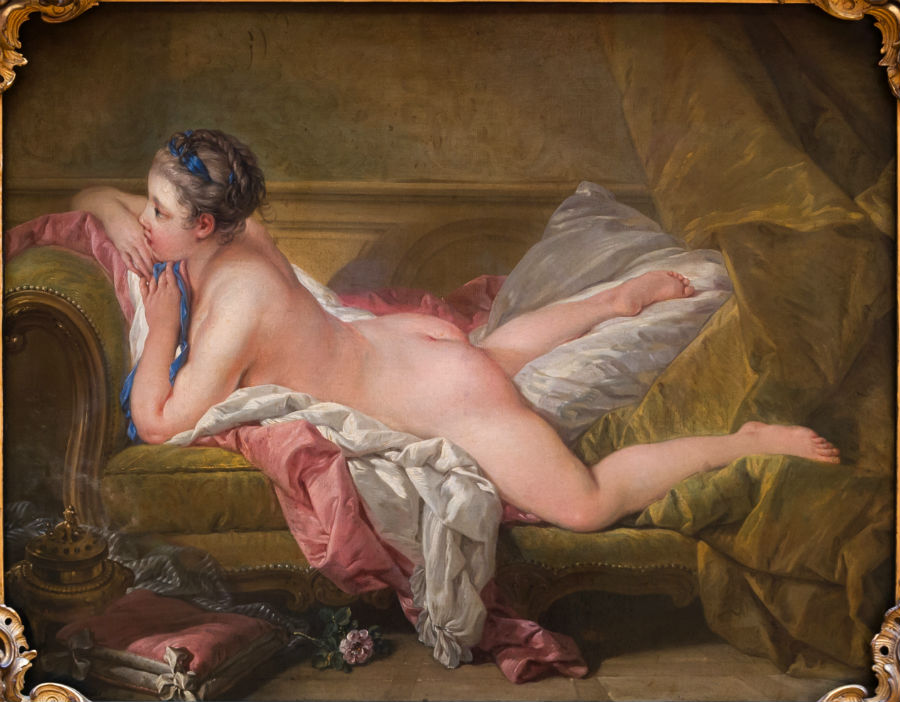
François Boucher, Mademoiselle O’Murphy, 1752
FRANÇOISE JOULIE ON FRANÇOIS BOUCHER
Grace and the Graces: Redefining Boucher
Françoise Joulie, art historian, is a curator in the Graphic Arts department of the Louvre Museum.
The following text is a condensed version of Françoise Joulie’s Introduction to the exhibition catalogue and her study of Boucher, François Boucher: Fragments of a World Picture
(Copenhagen: glHoltegaard, 2013 | Paris: Somogy éditions d’art, 2013).
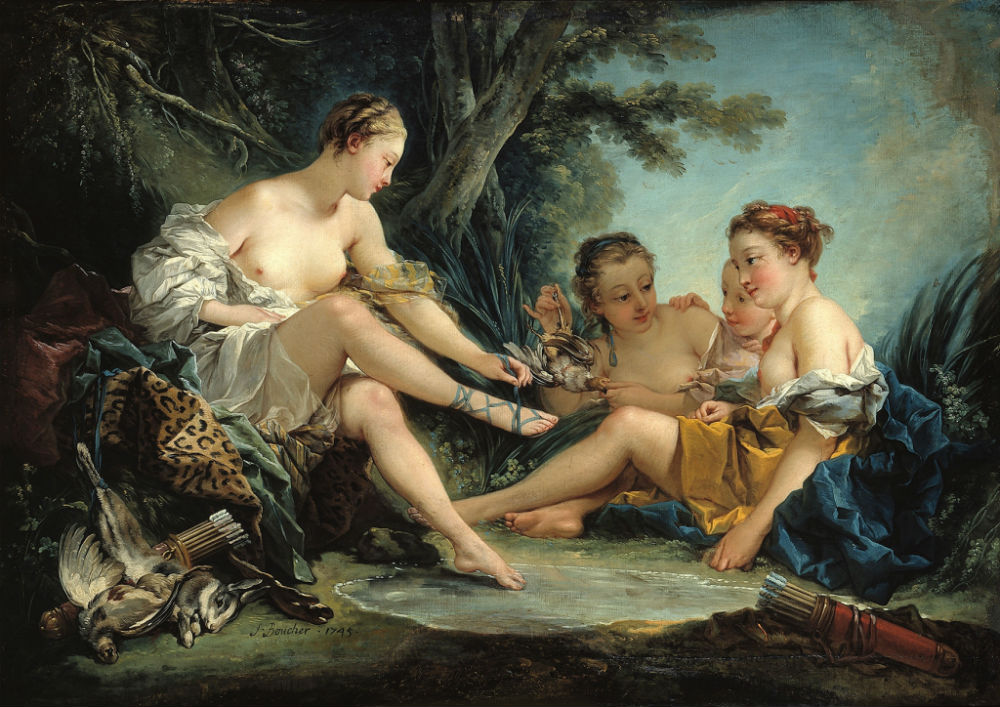
François Boucher, Diana’s Return from the Hunt, 1745
François Boucher’s role as a key figure in eighteenth-century France has come to light in recent research. Another Boucher has emerged—a Boucher who is quite different from the nineteenth-century perceptions of the artist. Born ‘dans la misère’, this son of a maître-peintre to Louis XIV became one of the eighteenth century’s most illustrious painters through talent and hard work. A much honoured premier peintre, the old man who died in the Louvre in May 1770, four years before Louis XV, had, as an artist of ‘prodigious facility’, created more than a thousand paintings and executed some ten thousand drawings. In his recueils of engravings he created a repertoire of forms that were still being copied a century later; the Beauvais, Gobelins, Vincennes, and Sèvres factories owe their excellence to his models.
As the link between Antoine Watteau, who died in 1721 during the Regency period, and Fragonard, whose life ended under the Napoleonic Empire, Boucher attracted students from all over Europe. If all great men become legendary, Boucher’s fame is tainted because of Diderot. The philosopher set the tone for two centuries; his wonderfully written commentaries on the Salons are still the yardstick by which the eighteenth century is judged—an eighteenth century in which the focus is very often on the Enlightenment, sanctified by the Revolution, of the second half of the century.
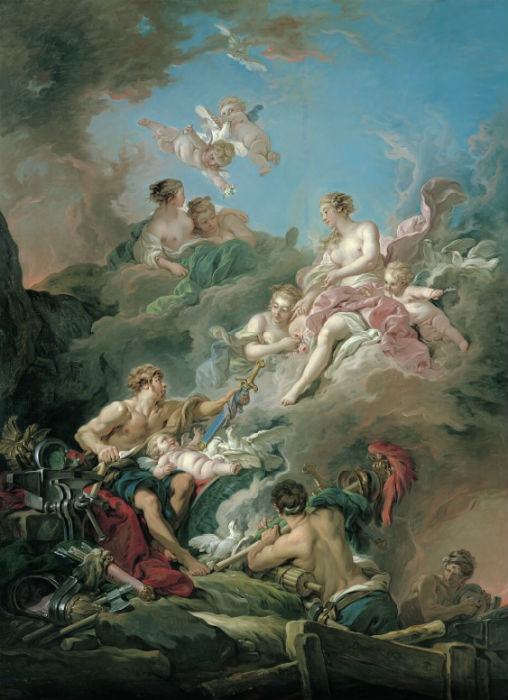
François Boucher, Venus at Vulcan’s Forge, 1769
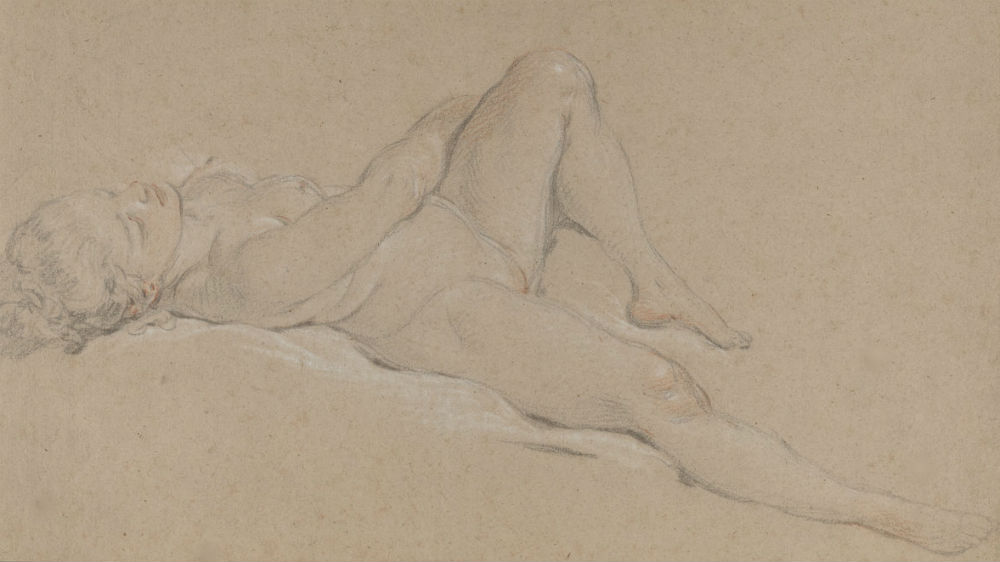
François Boucher, Venus, c.1754
Diderot’s writing is as eloquent and brilliant as Boucher’s paintings, and yet their mutual incomprehension was insurmountable. Various explanations have been given for Diderot’s vehement criticisms, which he himself admitted were excessive at times. The artist’s ‘depravity’, skillfully suggested in the philosopher’s commentaries, is one explanation. The accusation has now proved to be grossly exaggerated, and Diderot, who mixed in the same circles as Boucher, could not have been unaware of this. His famous text of 1767 mentioning a painting of a reclining woman with ‘her legs splayed about’, which he never even viewed, and his indignation at Boucher’s use of his wife as a model—this was common practice among artists, as it was forbidden to study female models at the Académie Royale—are examples of what surely must be considered as comments made in bad faith. The fact remains that Diderot set himself—it could even be said that he literally strove to do this—against an artist who seldom responded to these criticisms.
An apparently insignificant point of semantics raises the question of grace in Boucher’s art. Around 1750, the critics began to refer to the artist known as ‘le peintre de la grâce’ as ‘le peintre des grâces’. As he went from being the painter of grace to that of the graces, the critics began to criticize his painting. Throughout the eighteenth century, Boucher’s work was considered graceful, and the term has been used on countless occasions, even a long time after the painter’s death. Boucher’s grace does not originate from the themes he illustrated, which are based on themes from Ovid’s Metamorphoses, but from their treatment, which followed a new aesthetic approach consisting of diagonals and off-centre curves, with figures and postures arranged in sinuous arabesques. It is the new swirling grace of the rocaille that explains Boucher’s influence on the artists of his generation. But this grace is not merely an effect that could be described as a mannerism; rather, the young Boucher’s art demonstrated an acute awareness of the body, the body whose rhythmic and melodic lines are an expression of grace.
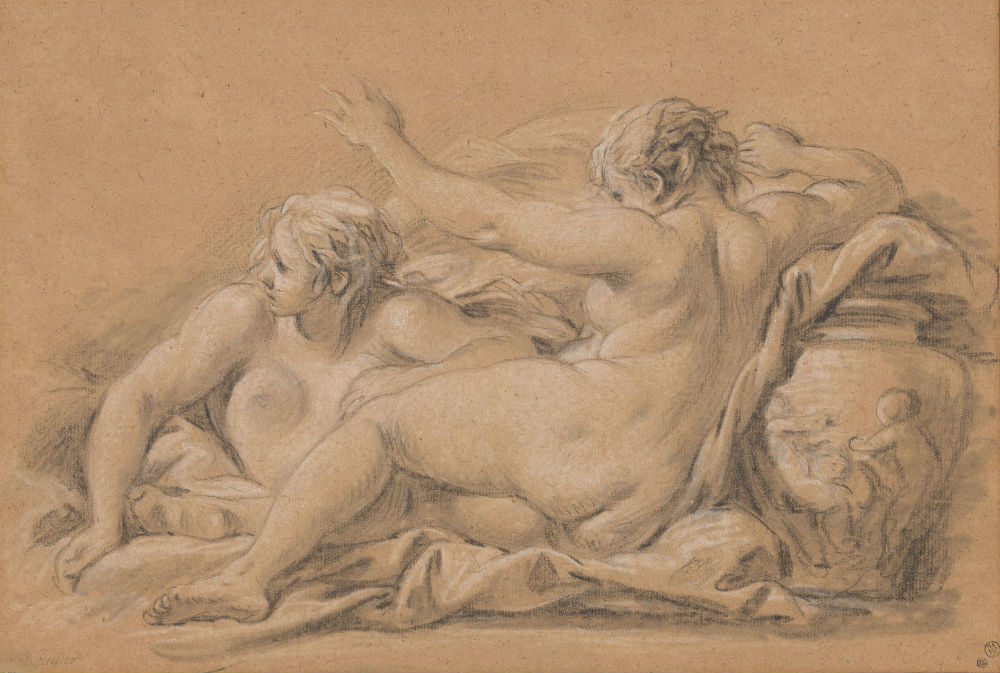
François Boucher, Two Nymphs, n.d.
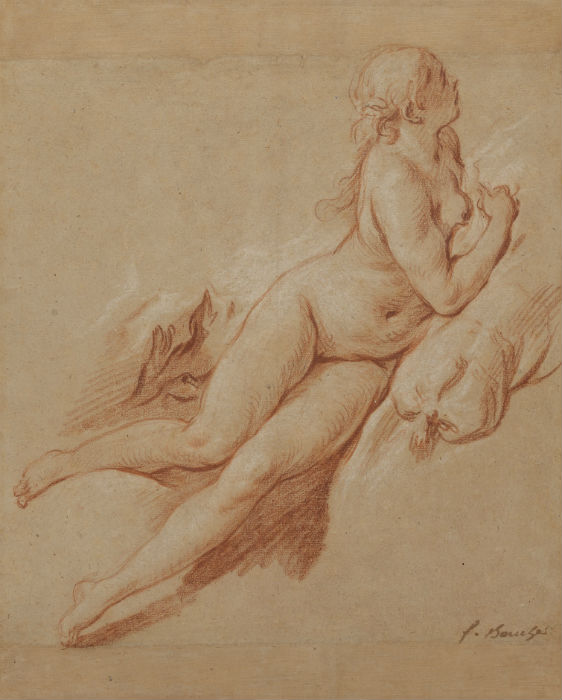
François Boucher, Study of a Reclining Nude, 1732-35
The grace in the gestures, the postures, the way the figures carry their arms is evident in Boucher’s very first drawings. They unambiguously define the action being represented, the figures’ characters and their interaction. This was nothing new, as pictorial art in the first part of the eighteenth century more or less readily adopted this language that was linked to movement, music and dance. The gestures in these arts are fluid and not emphatic; arranged in space, they obeyed instantly recognizable codes. Hence, the ‘rotation’ of each figure in the pictorial space contributes to the comprehension of a painting’s theme.
Like his predecessor Watteau, Boucher’s use of posture confers a theatrical quality on his work. He maintained close links with the theatre. But there is more to Boucher than his relations with musicians, people in the theatre, and composers. Boucher’s art is fundamentally the accomplished pictorial expression of this ‘monde-scène’, which emerged in the 1600s and ended around 1750. The body’s posture, which is more explicitly rendered than facial expressions in Boucher’s work, had to convey the action to the viewer, even from a distance—as in the theatre and in opera—and the gracefulness of the gestures therefore had to follow the same codes that were found in the theatre.
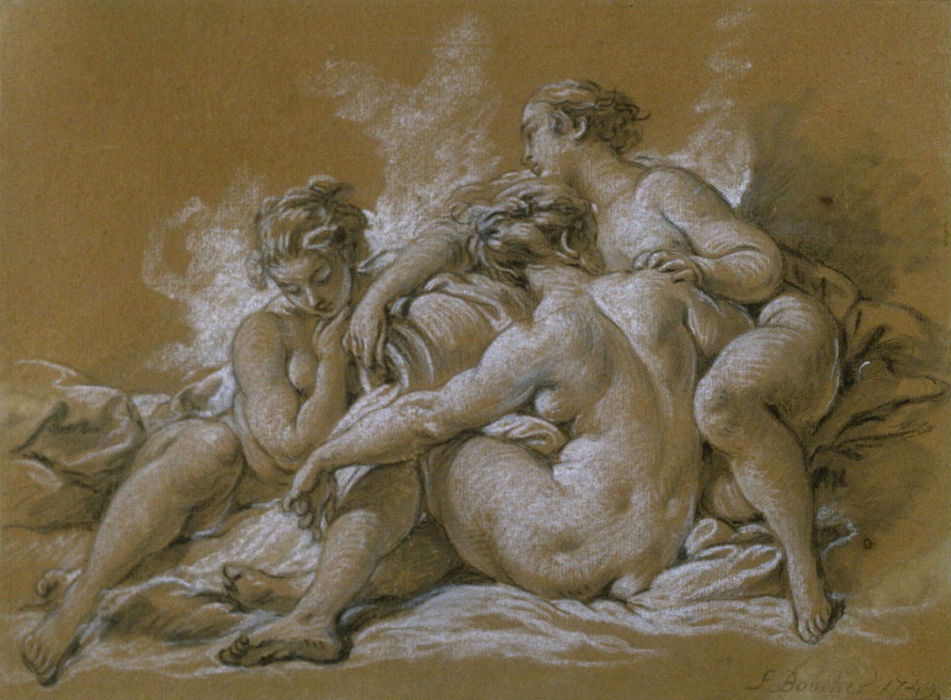
François Boucher, Three Nymphs, c.1749
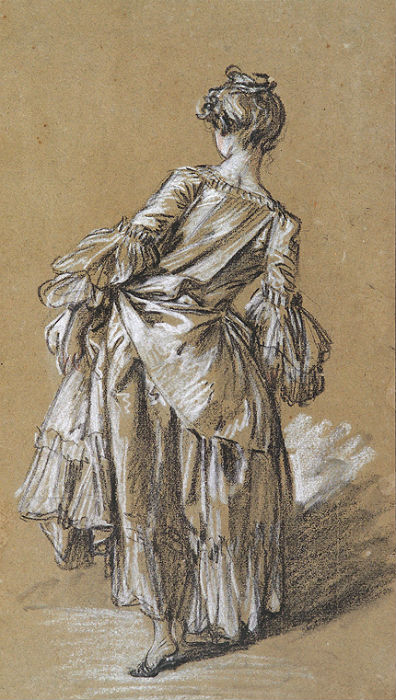
François Boucher, Standing Woman Seen from Behind, c.1742
This vocabulary of grace, linked to dance and movement, places his oeuvre in the framework of the aesthetics of Baroque theatricality, which was perfectly understood by his contemporaries. His paintings, drawings, and engravings are fascinating re-creations of all the artifice of the theatre, consisting of half-suggested notions, allusions, profils perdus, masks and inexpressive faces. The very space in Boucher’s work is that of the theatre, with skies interspersed with ‘sky-machines’, birds, putti, and light veils that create a link between the heavens and the earth.
Water and reflections play a leading role in Boucher’s work: the water gushes in the Livres de fontaines, is still in the landscapes executed in the 1740s, and swishing waves carry Arion, abduct Europa, and accompany Apollo in The Rising of the Sun and The Setting of the Sun. The use of reflections is based on the principle of mirror dances. This quest for an echo or resonance is at the very heart of Boucher’s aesthetics, and it is so integral to his work that it is one of the keys of his creative genius. ‘They’re all his old figures served up again and again’, wrote Diderot in his review of the Salon of 1765. It is impossible to consider his work without mentioning these mirror effects fostered by his skill as an engraver, and which give every figure its corresponding figure—like reflections in so many mirrors—in another painting, drawing, or engraving. These effects are the very essence of his art and are instinctively perceptible, even without in-depth analysis. All his work was clearly shaped by the aesthetics of the theatre and the opera, which underlies everything—from the overdoors to the most famous mythological and religious compositions. When the importance of this aspect of his art is grasped, everything falls quite naturally into place.
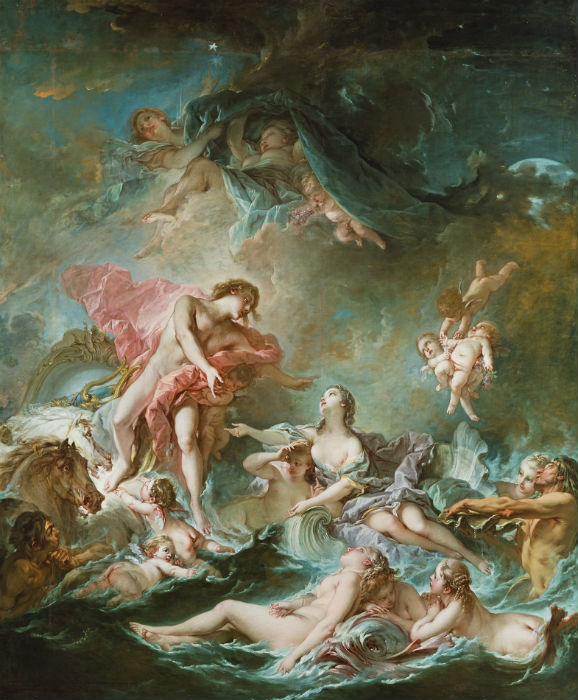
François Boucher, The Setting of the Sun, 1752
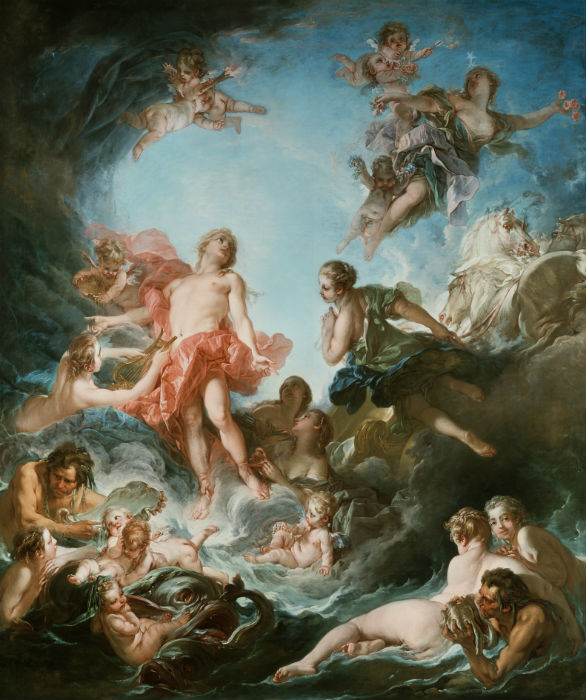
François Boucher, The Rising of the Sun, 1752
Hence, in 1753, when the aesthetics of the Enlightenment were formalized, Huquier wrote in his Lettre sur l’exposition des tableaux au Louvre with regard to The Rising of the Sun and The Setting of the Sun, which were enriched by the aforementioned postures, the arrangement of the arms, and the figures seen from behind, that ‘M. Boucher did not want to relinquish his title of painter of the graces’. Even if the notion is always understood in much the same way, the nuance between grace and graces is important because it represented the emergence of the first criticisms of his work and heralded Diderot’s involvement.
In the 1750s, there was a clash between the aesthetics of the ‘monde-scène’ of the first half of the eighteenth century and the aesthetics of the ‘monde-livre’ of Diderot and the Enlightenment. François Boucher was born in 1703 during the reign of Louis XIV; he began painting in 1721, the year of Watteau’s death. He died in 1770. He was therefore very much contemporary to the philosophical developments in France between 1750 and 1760 and was at the height of his career when this change occurred. The philosophy and new aesthetics of the Enlightenment were now openly expressed, and Diderot extolled an art based on the truth. One set of ethics was therefore replaced by another. This probably explains Boucher’s success during the first half of the century, and the harsh criticisms levelled against him after 1750. These criticisms were relatively rare, because the general public, described by Diderot as ‘the crowd of those who are strangers to real taste, to the truth, to just ideas, and to the seriousness of art’ still thought highly of the artist.
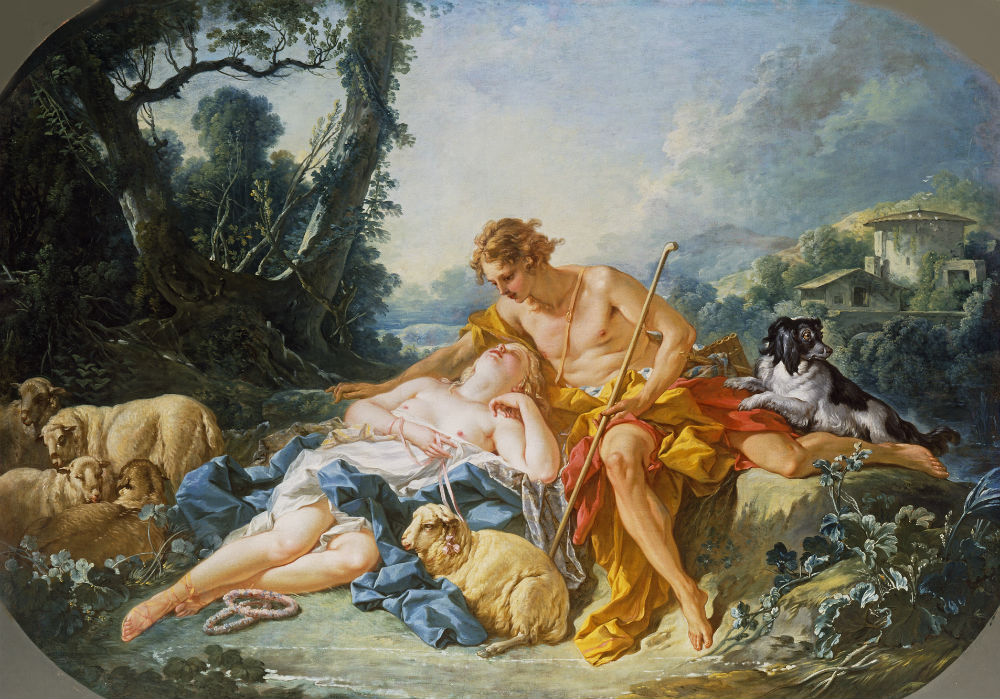
François Boucher, Daphnis and Chloe, 1743
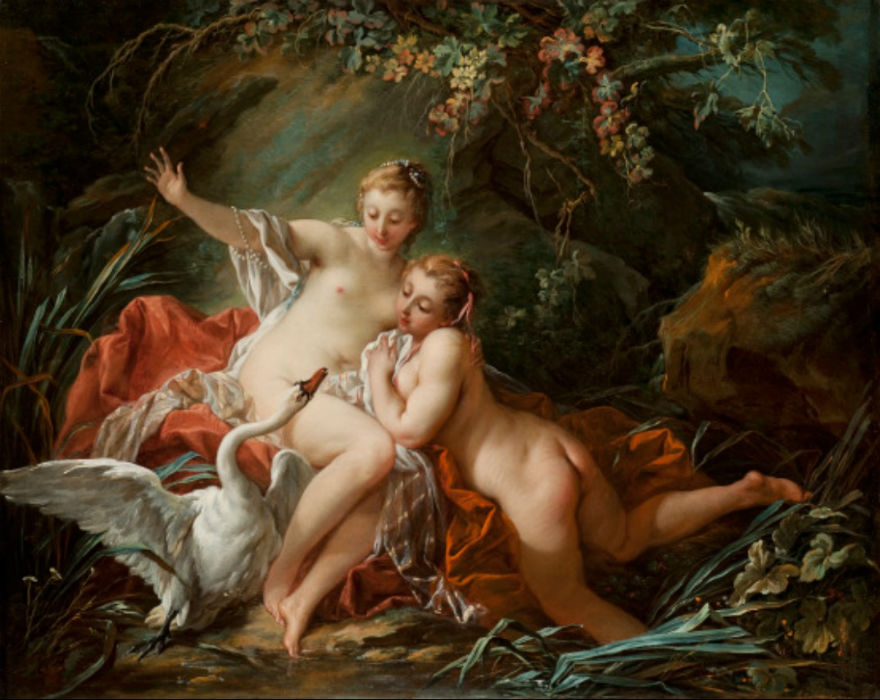
François Boucher, Leda and the Swan, 1742
Since the seventeenth century, Cartesian philosophy had gradually crystallized in reaction to the traditional philosophy in which Boucher and all his amateurs had been raised. Whereas the Cartesian philosophy of the Enlightenment was based solely on Reason, the traditional philosophy was rooted in Thomism and scholastic theology, and taught that men are rational beings who have a body and soul. Descartes’s idea of a possible separation between the rational being and the tangible being, or the theory of a possible error of sense that would be corrected by reason, could not be envisaged. When Boucher began painting in 1721, Cartesianism still had very little influence on thought; the traditional philosophy, which was very widespread before it was opposed and eventually overwhelmed by the ideology of Reason and the Enlightenment, still taught that man is a creature of intelligence with a supernatural soul and a tangible body. Everything is embodied in man, the body’s external grace is an expression of the soul. Dance and theatre were essential forms of expression. Music was a necessary corollary to this harmonious expression of the body. Expressed through dance, movement, and harmonic gestures, the grace of the ‘tour’, i.e. the grace of a well arranged figure, is very difficult to define: it is the venustas (beauty or sensuality) that was still used in 1761 to describe Boucher’s art, which had been associated with that of Apelles since the 1740s.
The ‘monde-livre’ of the second half of the century and artists who transmitted or illustrated knowledge through their painting were very alien to Boucher, a man of grace who was very much a part of the ‘monde-scène’. The ‘monde-livre’, Reason, and the Enlightenment did of course prevail after 1750. Nourished by increasingly precise scientific and literary knowledge, painting became learned, erudite, and archaeological; it contained lessons and had to arouse in the viewer ‘lofty, noble, and fine ideas, and satisfy the eye’. It explains Diderot’s admiration for Greuze, Vien, and Lagrenée, and his invective against Boucher, Fragonard, Bachelier, and Huet, which went as far as being completely biased when he wrote about Boucher, who was the most brilliant representative of the traditional culture. It could be argued that this break with tradition, which appeals to historians, was arbitrary and only involved Boucher. However, the divorce between the elite, which the Jesuits had fostered through their teaching, and the new ideas originating from the Cartesianism that the very same elite had defended and made victorious was well and truly complete in the decade 1750-1760. In such circumstances, the dissolution of the Jesuit teaching order became inevitable, and this did of course occur simultaneously throughout Europe.
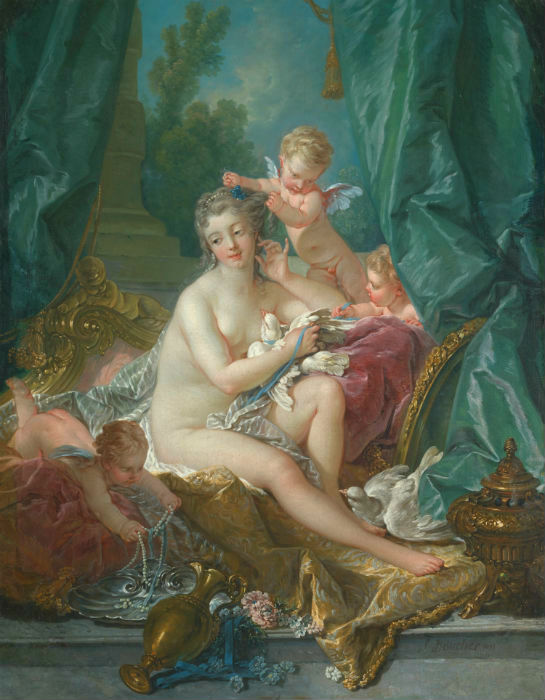
François Boucher, The Toilette of Venus, 1751
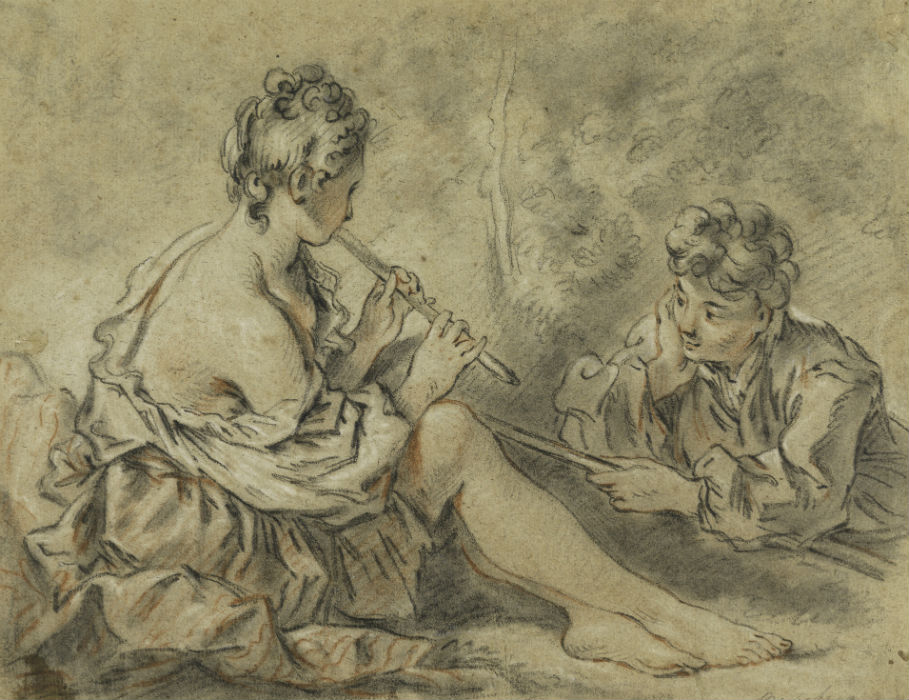
François Boucher, Shepherdess Piping to a Shepherd, c.1760
There remained ‘the graces’ and, above all, those that Boucher encountered in places of ‘ill repute’. The interest in dance, acting, and the world of the theatre was criticized and Boucher was portrayed as consorting with actresses and dancers: ‘the grace of his shepherdesses is the grace of Favart in Rose et Colas; that of his goddesses comes from Deschamps’, wrote Diderot in 1765, placing Boucher very firmly in the monde-scène, of which he was the interpreter. His associations with these people were questionable: ‘And what can a man who spends his life among prostitutes of the lowest sort have in his imagination?’ This ‘virtuous’ shift from the stage and the theatre to the morals of his models formalized the image of an immoral Boucher. Many small saucy paintings executed after 1750 by Baudouin, Charlier, Caresme, Norblin, Jollain, and Soldini were for this reason attributed to him throughout the nineteenth century, even if their skilled precision, which is closer to the rawness of de Sade or Rétif de la Bretonne, cannot be compared to the elusive eroticism of the first half of the eighteenth century, which Boucher shared with Marivaux and Crébillon.
Diderot’s resolute incomprehension contributed to the creation of another Boucher, and paved the way for approximations made, for example, by Gault de Saint-Germain, for whom Boucher had merely ‘sharpened his crayon or ground his colours only to charm the eyes of vice’. The nineteenth century saw the publication of many an inaccurate biography, such as that written by Arsène Houssaye in 1860, which were credible only if one chose to ignore what Boucher had actually painted.
Perhaps Boucher himself became aware of this discrete mise à mort of grace around 1750, without truly grasping the consequences. In 1747 he drew and engraved La peinture en butte à l’envie, and attempted to renew his themes and use light to make them dramatic. But nothing in this work conformed to Diderot’s taste, and the writer continued relentlessly to criticize the artist. I believe that the painter of grace and douceur de vivre is now sufficiently understood to liberate the artist from the distorting prism that was later imposed by the man of letters of the Enlightenment.
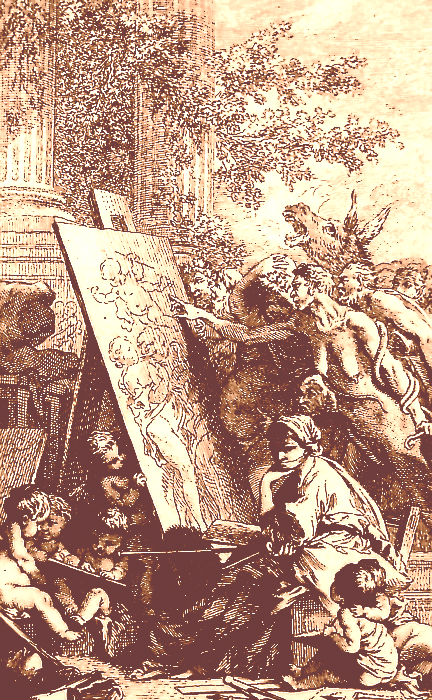
François Boucher, La peinture en butte à l’envie, 1747
